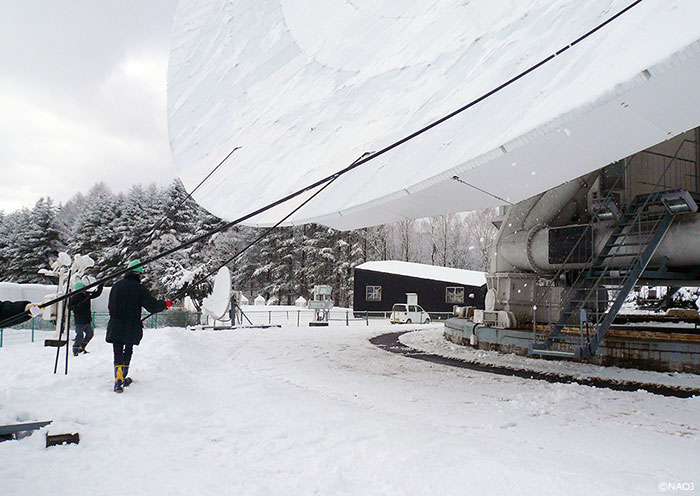Clearing Snow from the Face of the 45-m Radio Antenna
Photo・

| Date | December 20, 2013 | Photographer | Shuro Takano | Copyright | National Astronomical Observatory of Japan |
|---|
Photo・

| Date | December 20, 2013 | Photographer | Shuro Takano | Copyright | National Astronomical Observatory of Japan |
|---|
This picture captures the feeling of winter in Nobeayama Radio Observatory in a single frame. Winter is the observing season for the 45-m telescope, but when snow starts to fall, the observations must be interrupted as the antenna is turned in the direction which minimizes the snow sticking to its face. The snow which does stick is melted by pointing the antenna at the Sun during the day. But as you would expect in Nobeyama, where the high temperatures don’t rise above freezing in the middle of winter, there are often parts which don’t melt, particularly if it’s a wet snow. When that happens, we have to clear the snow from the surface as shown in this image.
Observing Season of the 45-m Radio Telescope
The observing season of the Nobeyama 45-m Radio Telescope is winter and spring when the humidity is low (from December through May). You are probably thinking that “observations must be difficult because of the harsh environment with low temperatures and snowfall.” But actually observations are possible precisely because it is cold.
The radio waves which the 45-m telescope observes are millimeter waves, which have one of the shortest wavelengths among radio waves. Because millimeter waves are easily absorbed by water vapor in the atmosphere, high humidity prevents us from being able to observe the millimeter waves from space. But for a given humidity, the lower the temperature, the less water vapor there will be in the air. In a crisp, clear winter, the colder it is the better it is for observations. This is why real observations are carried out in winter. The area is also surrounded by mountains, shielding it from interference by artificial radio waves. So it can be said that Nobeyama is one of the best locations in Japan for millimeter observations.
Text by: Kenzo Kinugasa (Nobeayama Radio Observatory)
Translation by: Ramsey Lundock (NAOJ)